
Classic Maya Polities of the Southern Lowlands
Integration, Interaction, Dissolution
- English
- ePUB (mobile friendly)
- Available on iOS & Android
Classic Maya Polities of the Southern Lowlands
Integration, Interaction, Dissolution
About this book
Classic Maya Polities of the Southern Lowlands investigates Maya political and social structure in the southern lowlands, assessing, comparing, and interpreting the wide variation in Classic period Maya polity and city composition, development, and integration. Traditionally, discussions of Classic Maya political organization have been dominated by the debate over whether Maya polities were centralized or decentralized. With new, largely unpublished data from several recent archaeological projects, this book examines the premises, strengths, and weaknesses of these two perspectives before moving beyond this long-standing debate and into different territory.
The volume examines the articulations of the various social and spatial components of Maya polity—the relationships, strategies, and practices that bound households, communities, institutions, and dynasties into enduring (or short-lived) political entities. By emphasizing the internal negotiation of polity, the contributions provide an important foundation for a more holistic understanding of how political organization functioned in the Classic period.
Contributors include Francisco Estrada Belli, James L. Fitzsimmons, Sarah E. Jackson, Caleb Kestle, Brigitte Kovacevich, Allan Maca, Damien B. Marken, James Meierhoff, Timothy Murtha, Cynthia Robin, Alexandre Tokovinine, and Andrew Wyatt.
Frequently asked questions
- Essential is ideal for learners and professionals who enjoy exploring a wide range of subjects. Access the Essential Library with 800,000+ trusted titles and best-sellers across business, personal growth, and the humanities. Includes unlimited reading time and Standard Read Aloud voice.
- Complete: Perfect for advanced learners and researchers needing full, unrestricted access. Unlock 1.4M+ books across hundreds of subjects, including academic and specialized titles. The Complete Plan also includes advanced features like Premium Read Aloud and Research Assistant.
Please note we cannot support devices running on iOS 13 and Android 7 or earlier. Learn more about using the app.
Information
1
Introducing Maya Polities
Theorizing Polity
Table of contents
- Cover
- Title Page
- Contents
- 1. Introducing Maya Polities: Models and Definitions
- 2. From the Ground Up: Household Craft
- 3. Negotiated Landscapes: Comparative Regional Spatial Organization of Tikal and Caracol
- 4. Political Interaction: A View from the 2,000-Year History of the Farming Community of Chan
- 5. Conceptualizing the Spatial Dimensions of Classic Maya States: Polity and Urbanism at El Perú-Waka’, Petén
- 6. Tomb 68-1, Copan: Deducing Polity Dynamics during the Early Classic Period and Beyond
- 7. La Sufricaya: A Place in Classic Maya Politics
- 8. The Charismatic Polity: Zapote Bobal and the Birth of Authority at Jaguar Hill
- 9. Governing Polities: Royal Courts and the Written Landscape of Late Classic Maya Politics
- 10. Ideas of City and State: Classic Maya Polities of the Southern Lowlands
- List of Contributors
- Index